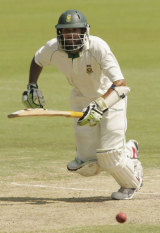The odd couple
There have been some odd couples before, but few could have matched the oddity of the pair who revived South Africa from what looked suspiciously like another top-order wobble this afternoon
Osman Samiuddin
12-Jan-2007
|
|

|
There have been some odd couples before, but few could have matched the oddity of the pair who revived South Africa from what looked suspiciously like another top-order wobble this afternoon. One, a Muslim of Indian descent - the first to represent his country - with a beard as lush as Mohammad Yousuf's and the other, one of cricket's more significant selections and the first black captain of his country.
Beyond the background, both Hashim Amla and Ashwell Prince are odd batsmen as well. Neither is a pleasure to watch; often viewing can be as hard work as they make their batting appear. There'll be nervous jabs and bunts aplenty, checked pushes mixed in. With Amla in particular, the edginess that deserts most batsmen after the opening exchanges never seems to leave him.
Often, for shock value, either will hit a surprisingly pretty boundary, driven or cut, and it'll be occasional enough to just about keep your interest, like a plot twist in a novel that drags.
That's not to discredit either of them, as the 90 runs they put on together allowed South Africa a way back into the game. Actually Prince is not so odd. He's one of those who when they get set, gives the impression that extracting a wisdom tooth with chopsticks might be easier. How do you get him out? With a pair of pliers, perhaps?
He furthers the lineage of one of cricket's age-old, lesser-celebrated occupations: the nuggety, gritty middle-order southpaw, a service men such as Larry Gomes, Shiv Chanderpaul and Graham Thorpe have so successfully provided in the past. They're not in the team to be watched or even appreciated. They're there to save the team's ass. Prince did it today and he has been doing it for the last year. To the relief of all watching, though, at least he was accompanied at the end by Herschelle Gibbs, with whom a greater contrast of batting styles cannot be imagined.
But the only reason the three didn't pull South Africa away from Pakistan completely was Mohammad Asif. It became clear today just why the prospect of losing him, even for a year, to the drugs ban, was such a frightening one to almost all of Pakistan. If it was put to vote, it may well have become the only issue ever to unite 160 million people across four vastly different provinces. His promise is singular, not least in the sense that almost everyone who sees him almost immediately and unanimously acknowledges his quality.
Why he wasn't rusty when he started no-one is sure, as this was his first international in over three months. That the pace wasn't there was about his only concession to time out of cricket, because the movement and the brain that mark him out certainly were in working order. It took him five balls to work out Graeme Smith, a few more for AB de Villiers and a few overs more to dismiss Jacques Kallis, which was just about right for the quality of the batsman. Amla's dismissal was possibly the best, the ball he cut away from him nearly 40 overs old at that stage. New ball, old ball, seam it he will.
One of the offshoots of his emergence has been the increased role of slip fielders, a breed almost nonexistent in Pakistan's history. His success comes in finding edges, not stumps and toes as has been the case. So with him around, we may even see a Pakistani slipsman take a century of catches. Younis Khan took two more at second, sponsored as Frank Keating once wrote of the Chappell-Lillee combination, by Asif's outswinger, and now has 57. Kamran Akmal did take his 100th catch though (the fourth Pakistani wicketkeeper to do so), also brought to him by an Asif outswinger. 'c Akmal b Asif' also has the makings of an oft-repeated scorecard entry.
He represented, alas, a solitary cheer in Pakistan's bowling. Rana Naved-ul-Hasan continues to provide the bowling equivalent, in reverse, to the Michael Vaughan conundrum. Vaughan's inability to switch Test class into ODI form is puzzling, just as Naved-ul-Hasan's failed efforts at reproducing good ODI form in Tests is. He swings the ball, attacks, has variety and is adept at reverse swing and yet has only looked a Test bowler on very rare occasions.
One Pakistani though might have found it difficult to suppress a smile as the bowlers toiled. With Waqar Younis as bowling coach, Pakistan conceded, on average, 12 no-balls per Test. In half an innings since his resignation, they've already bowled 19, which makes the decision to not try and keep him a little, well, odd.
Osman Samiuddin is Pakistan editor of Cricinfo